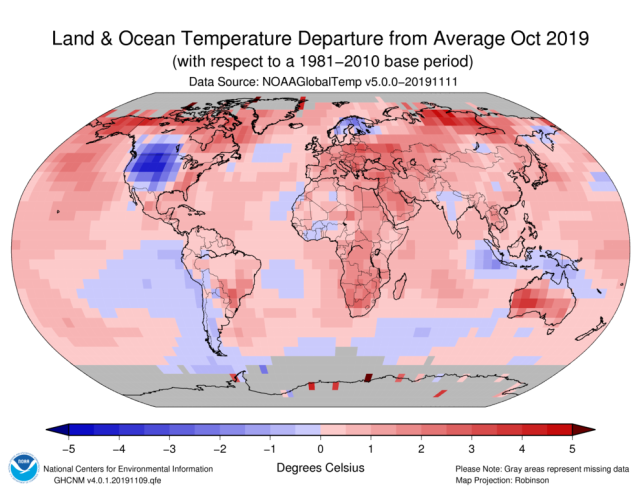Each month, the US National Oceanic and Atmospheric Administration (NOAA) puts out an analysis of the previous months weather after the final tally. The most recent update covers an odd October for the US, where the month included some terrifying wildfire conditions in California. This latest analysis also provides the long-range outlook for the winter months.
October provides another good reminder to Americans that their country is not the entire planet. Courtesy of the jet stream doing its thing, the western US experienced notably cool temperatures for much of the month. A dozen states had Octobers that ranked somewhere around the 8th coldest on record. Despite warmer temperatures along the East Coast, it was ranked as the 21st coldest for the nation.
All-time October single-day records set this year. Trough-west-ridge-east on steroids! https://t.co/B2yDfMOaJT (it's interactive!) pic.twitter.com/522vrAyZBB
— Deke Arndt (@DekeArndt) November 14, 2019
Looking globally, however, the western US was an outlier. Overall, it was the 2nd warmest October on record, behind only 2015. And with most of 2019 behind us, the final number for the year is crystallizing. NOAA puts the odds of 2019 being among the five warmest years on record at more than 99.9%. (So theyre saying theres a chance.) More specifically, theres now about an 85% probability of coming in second behind 2016—exactly the prediction we shared in early February.

Of course, October also saw a number of fires in California, and the state was in near-constant warnings of dangerous fire conditions, which were accompanied by massive (imposed) power outages and evacuations. We saw a repeat of the ugly combination of weather that led to deadly fires in recent years—a late arrival of the rainy season and strong Santa Ana and Diablo wind events.
Many areas hit record measures for vegetation dryness, including the nearly 78,000 acres that burned in the Kincade Fire north of the Bay Area. And as high air pressure formed over the interior of the West, the ingredients were there for fast, dry, warm winds racing downslope over California mountains and toward the sea, stoking wildfires like bellows.
California wasnt the only place feeling dry, as drought conditions extended across the Southwest, and only enough rain fell to barely help with drought in southern Texas. But again, the eastern half of the country was very different, with a great deal of precipitation lifting last month to the 8th wettest October on record for the nation as a whole.
ENSO on the fence-o
The remainder of NOAAs update relates to whats going on in the Pacific Ocean. There, a constant oscillation between El Niño and La Niña conditions—an eastward sloshing of warm water versus a westward blowing of colder deep water, respectively—has implications for weather patterns around the world. Because this “El Niño Southern Oscillation,” or ENSO, changes slowly, it can be forecast out about six months.
Thats the basis for NOAAs seasonal outlooks. These arent forecasts in the sense of the five-day predictions you rely on every day but instead show where the odds are tilteRead More – Source







